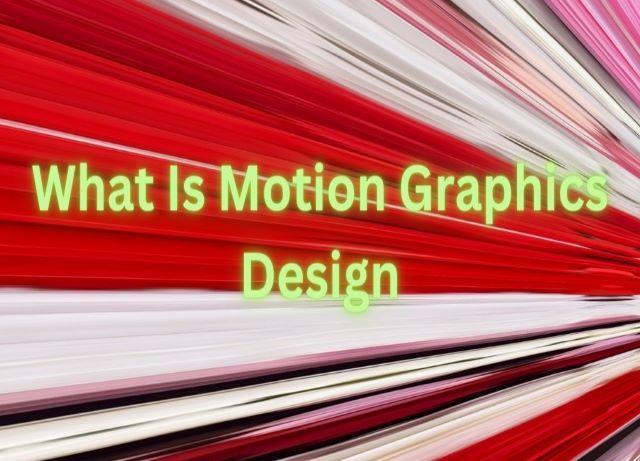Motion graphics design is the art of creating moving images through the use of animation and visual effects. It is a relatively new field that has emerged from the convergence of traditional graphic design and video production. Motion graphics designers use a variety of software programs to create their work, which can be used for both commercial and non-commercial purposes.
Some common applications for motion graphics include title sequences for films and television shows, commercials, corporate videos, website animations, and explainer videos. The possibilities are endless, and motion graphics provide a unique way to tell a story or convey a message. If you’re interested in learning more about this exciting field, read on to find out what motion graphics design is all about!
Motion graphics design is the process of creating graphic designs and animations that are used in films, television shows, video games, and other media. The purpose of motion graphics design is to add visual interest and appeal to the content. Motion graphics designers use various software programs to create their designs, which are then exported as digital files or printed onto film or video.
What Does a Motion Graphics Designer Do?
A motion graphics designer is someone who creates visual effects and animation for television, movies, video games, and other forms of media. They use a variety of software programs to create their designs, which can include 2D or 3D animation, stop-motion animation, or a combination of both. Motion graphics designers typically have a background in graphic design, fine arts, or even filmmaking.
Most motion graphics designers work freelance, which means they are not employed by any one company on a full-time basis. Instead, they work on a per-project basis with different clients. This gives them the freedom to choose their own projects and set their own schedules.
However, it also means that they may have to juggle multiple projects at once and be able to meet tight deadlines. The job of a motion graphics designer is constantly evolving as new technologies emerge. For example, with the advent of virtual reality (VR), many designers are now creating VR experiences that allow users to immerse themselves in another world.
As such, motion graphics designers must be willing to adapt to new trends and technologies in order to stay ahead of the curve.
What Motion Graphics Means?
Sometimes people get confused between motion graphic design and logo design services in Bangladesh. Motion graphics refers to the dynamic form of graphics. On the other hand, logo design refers to static design in most cases.
In its simplest form, motion graphics are visuals that move on a screen. This can be anything from a basic animation to more complex video effects. Motion graphics can be used for both web and television purposes, and often incorporate audio for added effect.
There are endless possibilities when it comes to motion graphics, which is why they have become such a popular tool in recent years. With the help of motion graphics, businesses can communicate their message in a more engaging and visually appealing way. Additionally, motion graphics can be used to add excitement and energy to any project.
Whether you’re looking to add some pizzazz to your website or create an energetic commercial, motion graphics are the way to go!
What are the 3 Types of Motion Graphics?
There are three types of motion graphics: kinetic, informational, and transitional. Kinetic motion graphics are those that use a lot of movement to convey information or tell a story. They are often fast-paced and can be used to add excitement or drama to a project.
Common examples of kinetic motion graphics include title sequences, commercials, and music videos. Informational motion graphics are more subdued and typically provide data or facts in an engaging way. They are often used for things like infographics, educational videos, or corporate presentations.
Transitional motion graphics are somewhere in between the two extremes. They usually make use of simple movements to segue between different sections of a video or presentation. Transitions can be something as simple as a fading effect or more complex animations that reveal new elements on the screen.
What are Examples of Motion Graphics?
Motion graphics are a subset of graphic design that focus on the creation of graphic elements in motion. This can include anything from simple animated GIFs to full-fledged videos and animations. Some common examples of motion graphics include:
-Animated logos -Title sequences – explainer videos
– educational videos – advertisements To create motion graphics, designers often use vector illustrations and animation software like Adobe After Effects.
This allows them to create graphic elements that can be easily manipulated and changed without affecting the quality of the image.
Motion Graphics Examples
Motion graphics are a great way to add visual interest to your website or video project. By incorporating moving elements into your design, you can create an eye-catching and engaging experience for your viewers. There are endless possibilities when it comes to motion graphics, so it’s important to spend some time planning and brainstorming before you start creating.
Once you have a clear idea of what you want to achieve, the designing process will be much smoother. To help get your creative juices flowing, we’ve rounded up some incredible motion graphics examples from around the web. From explainer videos to animated logos, these examples showcase the power of motion graphics and what they can do for your next project.
Conclusion
Motion graphics design is the process of creating moving images through the use of graphic design techniques. This can include anything from simple animations to complex video effects. Motion graphics designers often work with clients to create engaging and visually stimulating content for a variety of media platforms, including television, films, video games, and websites.



